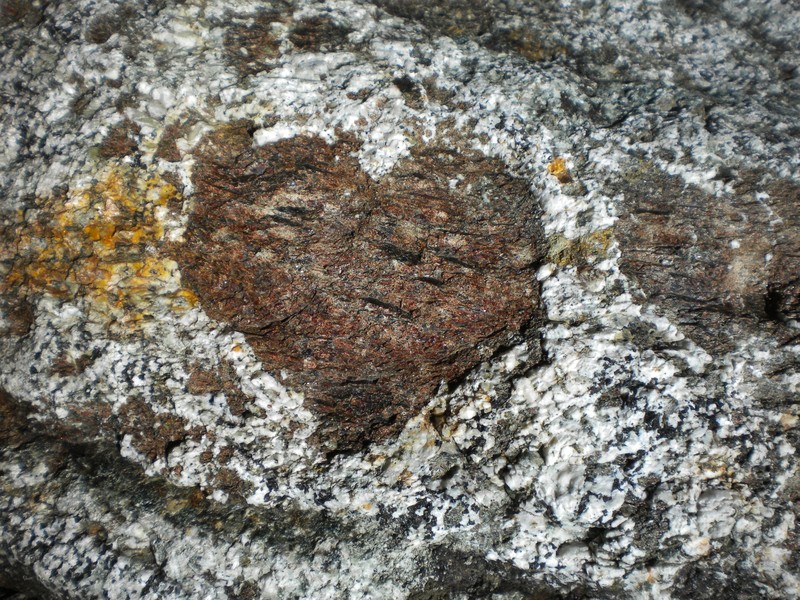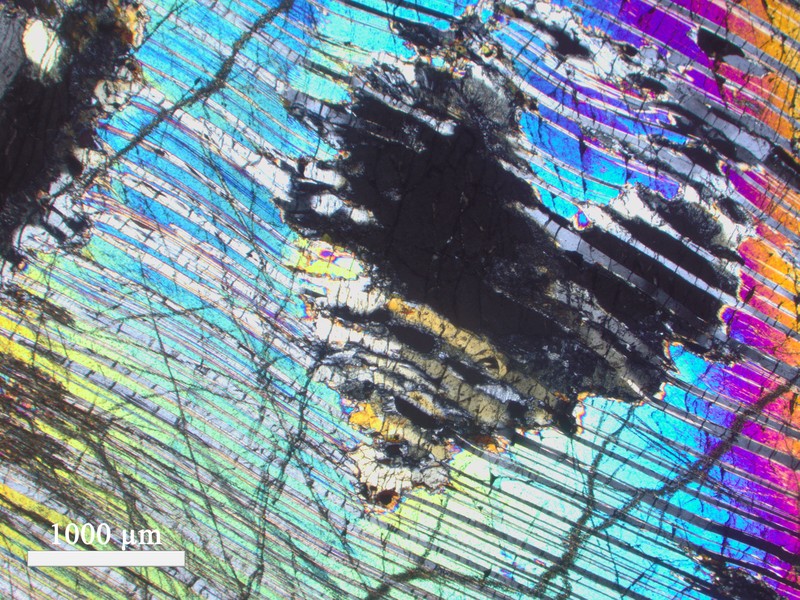We often have a way of seeing patterns in otherwise random features, and rock outcrops are no exception.

Pegmatite intrusion in mylonitc granite. (Credit: Lucy Chernale via imaggeo.egu.eu)
Do you see the heart on its side? To the untrained eye an outcrop like this is simply a heart-shaped feature in an otherwise grey rock. But to the geologist, the layers, swirls, shapes and colours tell a story. The ribbons in the granite show that the rock has been subjected to sheer forces and have slowly deformed in response to them, a process known as ductile deformation. Metamorphic rocks that have deformed in this way are known as mylonites. This sort of deformation only occurs below 4 km depth, meaning that this rock used to be buried deep below the Earth’s crust and has slowly been brought to the surface.
The lighter, heart-shaped area is an intrusion of pegmatite, an igneous rock composed of large crystals (over 1 centimetre long) that would have filled a space in the country rock. Big crystals form when melt cools slowly, and the pegmatite’s centimetre-long ones show the intruding melt was well-insulated by its surroundings, allowing the crystals to grow.
It’s not only the larger patterns within an outcrop that tell a story, but the arrangement of minerals within the rock. Garnets are relatively common rock-forming minerals, and they’re not always the glossy red gemstones jewellers are after. In fact, the colour of garnet can vary widely depending on its chemical composition.

Heart-shaped garnet in a mafic granulite. (Credit: Barbara Kunz via imaggeo.egu.eu)
This brown garnet heart sits amid an igneous rock rich in iron and magnesium – a mafic rock. Mafic lava flows relatively easily because it is low in silicates – the minerals that control lava’s viscosity. Its slow-moving counterpart, felsic lava, is filled with feldspar and quartz, and a lot more silicate. Looking at the minerals in an igneous outcrop lets Geologists work out whether the lava flowed rapidly, or was more slow-moving. Volcanologists can make models of the two in the lab using golden syrup, which, like lava, is a Newtonian fluid (a liquid that doesn’t change viscosity when forces act on it). Adding water to the syrup makes for a more mafic lava and adding lentils, rice and sugar simulates one that is rich in crystals!
Back to the rocks. Microscopes make it possible to view the wonders of rocks on a much smaller scale. You can see the relationship between mineral grains, the condition of the crystals, and piece together the last parts of the rock history puzzle.

Photo-micrograph of exsolved garnet in lamellar pyroxene. (Credit: Fatima El Atrassi via imaggeo.egu.eu)
A searching through Imaggeo reveals yet another garnet heart! And this one is tiny, a mere 2-3 millimetres across! The garnet is nested within a mineral known as pyroxene. Pyroxene forms at high temperatures and can become unstable as the temperature decreases, causing it to form this striped pattern. The patterns each mineral forms, and whether they sit as small inclusions or jointed grains can tell us a little more about what happened to the lava as it cooled and crystallised.
Rocks are incredible windows into the history of the Earth, and indeed our solar system. Take a closer look next time you’re on a beach, beside a cliff, or standing on a set of stone steps – you might find out more about the Earth than you were expecting!
By Sara Mynott, EGU Communications Officer



maryam
these are marvelous rocks.